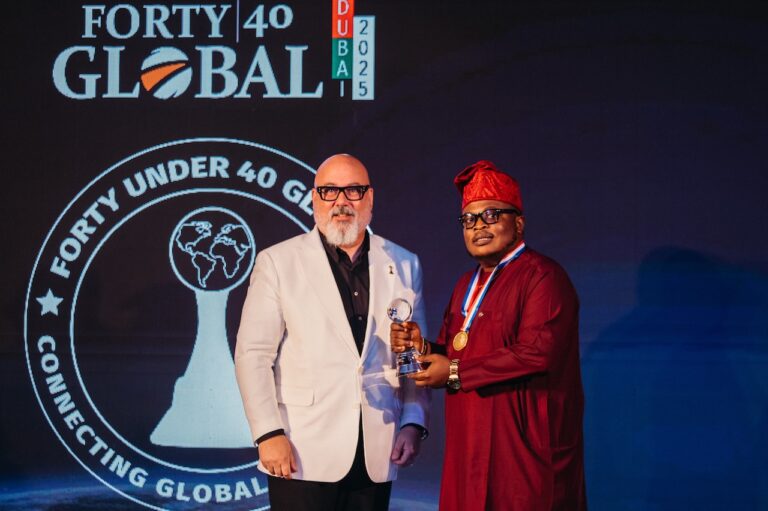Dubai, UAE — April 14, 2025 — Nigerian marketing powerhouse Ayodeji Razaq has etched his name on the global stage as he emerged the winner in the Marketing & Communications category at the prestigious Forty Under 40 Global Awards 2025. Held on April 12 in Dubai, the ceremony honored visionary leaders from around the world under the theme “Connecting Global Champions.”
Dressed in a rich burgundy agbada and red cap, Razaq stood tall as he received his award from Mike Tankel, symbolizing a powerful moment of pride for Africa’s growing marketing and communications industry.
As Group CEO of RED and Co-Founder of The People Company, Razaq has built a legacy of culture-driven brand strategy, redefining the way African brands engage audiences. His recognition at the global level celebrates not just individual brilliance, but also Africa’s rising footprint in global brand building, strategic communication, and marketing innovation.
“Winning on a global stage is more than a personal honor. It’s a powerful testament to the world-class work we do in Africa,” Razaq said during his acceptance speech. “We’re not just telling stories — we’re crafting narratives that shape global perceptions and position Africa as a force in today’s economy.”
A Champion Among Global Innovators
The Forty Under 40 Global Awards celebrate leaders redefining their industries, and Razaq now joins an elite class of international changemakers. His award reflects the increasing influence of African expertise and the creative renaissance sweeping across the continent.
This year’s ceremony brought together winners from multiple countries and sectors, creating a mosaic of innovation, cultural diversity, and visionary leadership.
Some of the other notable honorees included:
-
Damilola Dania (Nigeria) – A brand innovator at Unilever Nigeria, celebrated for community-focused campaigns and brand transformation.
-
Ahmed Mohsen Mohamed Sadek (UAE) – Civil engineering expert leading major infrastructure revolutions in the Middle East.
-
Reece Mennie (UK) – Pioneer in merging traditional and digital marketing strategies to reach global audiences.
-
Fiza Farhan (Pakistan) – Social entrepreneur championing climate action and gender equality.
-
Olufemi Oguntamu (Nigeria) – Renowned for reshaping digital media and brand strategy in West Africa.
-
Darren Meltz (South Africa) – Founder of SecretEATS, reshaping dining experiences with sustainability at the core.
-
Nicole Ansoni (Rwanda) – Business leader with multinational ventures reflecting innovation and strategic depth.
-
Giorgi Astamadze (Georgia) – Financier bridging creative business ideas with global capital networks.
-
Harun Lone (Switzerland) – Innovator in sustainable water purification and social impact solutions.
A Landmark Moment for Africa
Razaq’s award marks a defining moment for Nigeria and Africa at large. His work amplifies African voices, turns local insights into global strategies, and showcases the continent’s growing influence in business storytelling.
The award ceremony, held at Hilton Garden Inn Hotel, Business Bay, concluded a three-day leadership immersion featuring business tours, networking events, and knowledge exchange among global leaders. Since its inception, the Forty Under 40 Global Awards — organized by Xodus Communications — have recognized over 2,000 exceptional professionals across 17 countries.
About the Forty Under 40 Global Awards
The Forty Under 40 Global Awards spotlight trailblazing entrepreneurs, innovators, and business leaders under 40 who are shaping the future of their industries. It celebrates bold vision, cultural diversity, and the power of next-generation leadership to drive global impact.


